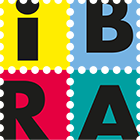_____
IBRA Treasury
The IBRA Treasury
The concept of the IBRA Treasure Chamber is based on the idea of offering visitors the highest philatelic enjoyment with just a few exhibits. This should make it possible to intensively study the stamps and covers presented as well as the texts on them. The IBRA Treasury is unique in that (with one exception) there are no plans to put the exhibits on public display after IBRA.
Left entrance
- Classical German Rarities: Legends of the Old German States
- Classical international rarities: The Bordeaux Letter
- Rarities of more modern times: The Hiroshima Letter and The Audrey Hepburn Stamp
Legends of the Old German States
These three rarities are located on the left side after the entrance. All three pieces are virtually the crowning glory of their respective collecting areas and fulfil the very highest standards in terms of importance within the stamp era of the Old German States.
On 1.11.1849 the first stamp of an old German state appeared in the Kingdom of Bavaria, namely the 1 Kreuzer black. The letter shown, which was posted on the day of issue, is a unique specimen and probably the most important documentation of the start of the stamp era of the old German states. Regarding the issue of this stamp, it is worth mentioning that the issue fell on the All Saints' Day holiday and therefore only the larger post offices were open in Bavaria, so that only a few stamps are known to have been used on this day.
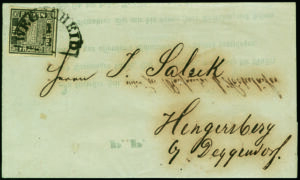
The second stamp of the Old German States is a 3 Pfennig stamp (the so-called "Sachsen Dreier"), issued on 1.7.1850. It was printed on relatively small sheets of 20 stamps each, and the only surviving original sheet is shown. This was in a number of large collections, including those of Philippe La Renotière de Ferrary, Maurice Burrus and Gerold E. Anderegg. In a collection of the stamps of this area, the original sheet is without any doubt the key piece par excellence - and a real "eye-catcher" anyway.

Certainly the most famous misprint of the old German states is that of Baden, where a plate of the 9 Kreuzer stamp of the 1851 issue was probably printed on the blue-green paper of the 6 Kreuzer value instead of the intended purple-pink paper. It was only discovered in 1894. More than 100 years ago, Carl Lindenberg acquired the presented letter for the former Reichspostmuseum. Today it is part of the collection of the Museum Foundation Post and Telecommunications. Only three cancelled copies of this misprint are known, one other letter and a small letter piece.
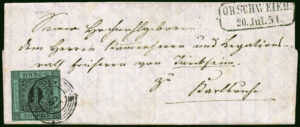
This exquisite show is made possible by the auction house Köhler in Wiesbaden.
If you continue clockwise, you will next come to the display case with the Bordeaux letter. This is already legendary because it is considered the most valuable letter in the world.
The Mauritius Bordeaux cover presented in the Treasury is the only one to bear both stamps of the first Mauritius issue. The cover is complete with text, and due to the presence of the postmarks, the postal route from posting to delivery can be traced without any gaps. The stamp cancellation was made with the PENNY POST frame cancel, the frame cancel COLONIES/& ART. 13 marked the origin of the letter, and the red two-circle cancel ANGL. / BOULOGNE was struck on arrival from Great Britain. On the back of the letter are the postmarks MAURITIUS POST OFFICE / Oc 04 1847 and SHIP LETTER / PLYMOUTH, as well as the two-circle postmarks of Paris and Bordeaux. The letter was carried by private ship by sea to Plymouth and was stamped on arrival with the previously mentioned postmark.
The stamps of the first issue were engraved by Joseph Osmond Barnard, who was born in England in 1816 and came to Mauritius in 1838. The stamp image was based on the stamps of Great Britain valid at that time, which showed the head of Queen Victoria in profile and also had two values, namely one penny and two pence. The colours - reddish brown for the one penny and blue for the two pence - were also adopted. These locally produced stamps and their "primitive" design gave Barnard a permanent place in the philatelic chronicle of Mauritius. Five hundred of each stamp were printed from a single plate of both values and issued on 21 September 1847. The stamps were produced by intaglio printing, an innovative process at the time.
Many of the stamps were used by the wife of the Governor of Mauritius to send invitations to a ball to be held the following weekend. Today, most of the surviving stamps from the first Mauritius issue are in museums in the UK (British Museum and Royal Collection), Sweden (Post Museum) and Germany (Deutsches Museum Munich).
The Bordeaux cover can be seen through the intermediary of Briefmarkenhaus Richard Borek GmbH & Co. KG.
Sources of the texts on the Bordeaux letter: Homepage David Feldman, wikipedia
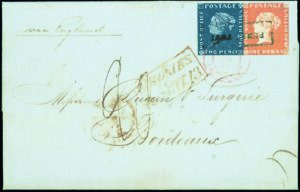
The two display cases with the Hiroshima letter and the two Audrey Hepburn stamps conclude the small tour through this room of the Treasury.
While the classical period and the period up to the beginning of the 20th century offer many opportunities to display stamps and covers that can be described as rarities, this is rather limited in the more modern period. We are therefore particularly pleased to be able to present a total of three pieces in the Treasury that are not only rare but are likely to be familiar to many visitors. One of them even dates from the time after the introduction of the euro.
The first of the three pieces is the so-called "Hiroshima letter". This was found during World War II shortly after an atomic bomb was dropped on the Japanese city of Hiroshima on 6 August 1945 during clean-up work in the rubble of a bank near the city's railway station about two kilometres from ground zero of the detonation. It shows hardly any external damage, but is radioactively contaminated. An official measurement revealed a dose rate of 0.05 mr/h. For this reason, it was placed in a lead sleeve and covered with bulletproof glass. The letter reached Germany via the United States and was acquired by the Bund Deutscher Philatelisten after the death of its owner as an important contemporary testimony. It is shown here as a reminder for peace and against the unlimited use of weapons of war. This presentation thus pursues deeply humanitarian goals.
The Hiroshima letter is in the possession of the Bund deutscher Philatelisten e.V. and is made available by them.
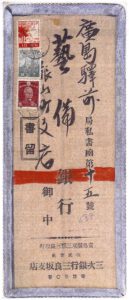
From the possession of the BDPh
The two Audrey Hepburn stamps that will be on display in the Treasury can be described as "contemporary". In the meantime, they have become almost legendary, and this is due to their very special background story. The stamp, which shows a photo of the American actress Audrey Hepburn from the film "Breakfast at Tiffany's" and was to appear as part of the 2001 welfare issue, had to be withdrawn from sale because Hepburn's sons refused to give their consent. The reason was the depiction of their mother with a cigarette holder, which was seen as undesirable. As a result, all stamp stocks had to be destroyed. The specimens known today are presumably from the sheets received by the Ministry of Finance. Generally considered the most valuable modern stamp in the world, the specimens on display in the Treasury are a cancelled corner margin piece and a letter tear with a round cancel. Both pieces are unique. In addition to a mint miniature sheet, only five used individual stamps are known today.
The two stamps are provided by the auction house Christoph Gärtner.
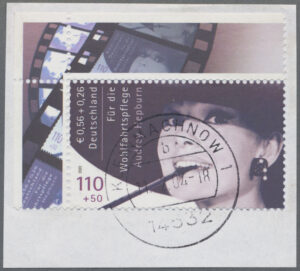
The show "Germania: Marke und Mythos" is presented to the right of the IBRA Treasury.
